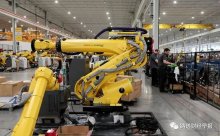
The manufacturing robot map of the US factory waiting for delivery, the invasion of the robot map of Reuters/Rebecca Cook robots, can also slow down the economy. According to data prepared by the Association for Advancing Automation, North American companies have greatly reduced their robot orders in the second quarter.The organization, also known as the A3, said that the slowdown in order began at the end of last year because the increase in interest rates and the slowdown in economic growth suppressed the demand for new robots."We don't even consider buying robots now," said Nancy Kleitsch, chief financial officer of Phoenix plastic component manufacturer Icon Inject Molding.Like many manufacturers, Icon's business has increased during the new crowns.But Kleitsch said that the demand for pipes and other products of the company has now dropped to at least seven years. ** inflation and growth worry ** Many other companies seem to hesitate to purchase robots like Icon.Factory and other industrial users, including e -commerce warehouses and medical testing companies, ordered 7,697 robots in the second quarter, a year -on -year decrease of 37%.In the first quarter, it fell 21%, and the fourth quarter of last year fell 22%.During the epidemic, robots were selling prosperous.According to A3 data, although economic slowing at the end of last year, 2022 is still a year of orders for orders.But robots are just one of the types of equipment required by the company, and other expenditure indicators in the US economy are better.According to the US Department of Commerce, the non -defense capital of non -defense capital to deduct aircraft in July increased by 0.1%over the previous month, which shows that after the second quarter rebound, the investment in various equipment may continue to grow."This is not to say that we are bored with automation," said A3 President Jeff Burnstein in an interview with Reuters."But when people are worried about inflation and economy, everything will be blocked and will be suspended." In the recent prosperity period, some industries seem to invest excessive investment in robots.For example, as expected commodity demand will continue to grow rapidly, e -commerce companies have built highly automated warehouses.But this growth has not appeared.Burnstein said that another problem is that due to the concerns of the supply chain delay, the company ordered too many robots."They don't worry about what they need, so they buy too much," he said.It also said that the weak state of robotic orders will last until the fourth quarter or early next year. ** Usage has expanded ** One of the factors that have promoted robot sales in the past few years are the tight labor market.The unemployment rate in July was 3.5%, which was close to more than 50 years.But the shortage of labor is relieved.The U.S. Department of Labor said on Tuesday that as the labor market slows down, indicators to measure US vacant positions have fallen in July to the lowest level in nearly two and a half years.At the same time, robots continue to penetrate into an increasingly widespread work area.In the past, they were mainly concentrated in automotive factories and their suppliers, and now this part of them still accounts for a large proportion of all robotic orders.However, A3 data shows that in recent years, robots have spread to various fields, including construction sites, hospitals and food processing plants.Aaron Anderson, an innovative director of Swinerton, California Kangkode, California, said his company has begun to use robots to drill on the concrete ceiling to laid the way for workers to install other mechanical system pipelines.But Anderson said it is difficult to prove that the cost of buying one of the machines is reasonable.He said that because the scale and complexity of the construction projects are different, sometimes there is no robotics at all.Swinerton's response strategy is: renting machines, so the cost is much lower.




